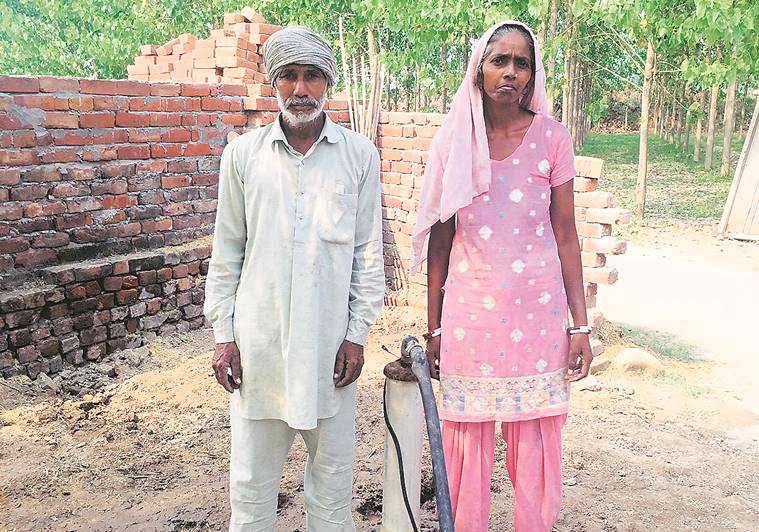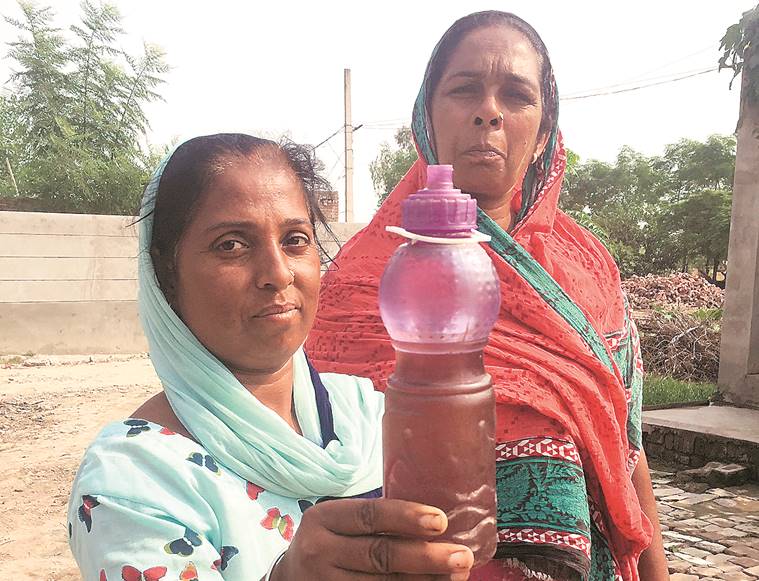It was nearly a year ago that Wazir Singh (47) decided to get a submersible water pump installed at his home. A daily wager making Rs 300-500, Wazir invested nearly three months of his earnings, hoping that finally, his family may get something as basic as clean drinking water. The hopes were soon dashed.
“The water, being drawn from a depth of 230 feet, stinks and turns yellow in few hours. I spent Rs 27,000 on this pump thinking family will get clean water to drink but it seems we will not get it, at least in this lifetime,” says Wazir, his home near the banks of river Sutlej at village Walipur Kalan of Dakha, an assembly constituency where bypolls are scheduled for October 21.

In this village in rural Ludhiana, the stinking, toxic black waters of polluted Buddha Nullah stream, carrying the domestic, sewage, industrial and other waste of Ludhiana city, meets the comparatively cleaner waters of Sutlej. For nearly four decades, some 1,000 residents of Walipur Kalan have been bearing with the suffocating stench of the nullah water. They do not get clean drinking water in their taps and now even groundwater has turned bad.
While the successive governments and local MLAs have failed to find any solution, those who can afford have got RO purifiers installed at their homes. Some families ferry 2-3 tankers a day from the common village RO paying Rs 100 a month.
The ones suffering the most here are poor families, living on the village periphery near the river banks, with no option but to drink the contaminated water. Several of them are now suffering from deadly diseases.
 Gurmeet Kaur shows dirty water. She and her daughter are Hepatitis-C patients. Express Photo by Divya Goyal
Gurmeet Kaur shows dirty water. She and her daughter are Hepatitis-C patients. Express Photo by Divya Goyal
With her sunken eyes, parched lips and pale face, Gurmeet Kaur, a hepatitis-C patient is now more worried for her daughter Harjot (12) who too has been diagnosed with the disease now. Her husband is a daily wager. The couple and their three children consume the contaminated water. “The water from our taps stinks and turns yellow within hours. My children refuse to drink it at times but we have no option. We cannot afford RO or a new pump. Some rich families who have pump installed are not getting clean water so why waste money. I do not care about myself but I want my daughter to be treated. My children keep felling sick often. No party or candidate talks of clean water for us,” says Gurmeet showing a water bottle she filled last night, now stinking and yellowish.
Opposite to Gurmeet’s house lives Swaranjit Kaur (40) whose 17-year old daughter Manpreet Kaur was diagnosed with stomach cancer. “No party has done anything for us till date. Is this how we are supposed to live? Entire city’s waste is dumped in our village and here we ferry water tankers on cycles. Is something as basic as clean drinking water not our right? Is this our fault if Buddha Nullah meets Sutlej here at our village? Why should we suffer? Ask politicians to come here and stand for a minute amid this stench,” she says.
“My daughter used to complain of stomach ache regularly. When detailed tests were done, she was diagnosed with stage-1 cancer. We got her operated and now we ferry two water tankers daily from village’s common RO to get clean water,” she adds.
Story continues below this ad
Mincing no words on how people in his village are being deprived clean drinking water, sarpanch Bhinder Pal Chawla (42), a Congress leader, says, “Till 1976, the water of Buddha Nullah was clean. It was, in fact, called Buddha Dariya. But since 1980s it started carrying city’s pollution and dumping it in our village. The condition deteriorated after 1990. Now black stinking water of nullah accumulates here. Outsiders cannot even stand in this stench”.
“My father died of liver cancer in 2016. From 2013 till now there have been at least 25 deaths due to Hepatitis-C in our village. Some have been diagnosed with cancer also. Currently there are 90-100 Hepatitis-C patients, most can’t even afford treatment,” he says, adding “Most families in the village are now without elderly – they are dying in their 50s and 60s”.
The village has 880 votes.
Asked if his affiliation with ruling Congress has helped the village in past two-and-a-half years, he says, “Let’s see, maybe Captain Sandeep Sandhu will do something now. I have spoken to him…”
How bad is pollution in Buddha Nullah
In April 2019, the Punjab Pollution Control Board (PPCB) started monthly sampling from 15 locations where the stream flows. As per the average Buddha Nullah monitoring data from April to June, the biochemical oxygen demand (BOD) was recorded from 65 to 2,112 mg/l while it should not be more than 30. At three locations it was more than 1,400 mg/l including the highest 2,112 mg/l at Haibowal dairies. The fecal coliform (bacteria levels) were recorded from 1.70 lakh (MPN/100 ml) to the highest 58.31 lakh (MPN/100 ml). At eight locations it was more than 20 lakh MPN/100 ml and at two locations more than 32 lakh MPN/100 ml. Ideally, it should be nil.”The data indicates dangerously high levels of water pollution, harmful for human life in several ways,” says Charanjit Singh, scientific officer, zonal lab, Ludhiana, PPCB.

 Wazir Singh shows the submersible pump that he got installed for Rs 27,000. The pump draws water from a depth of 230 ft, but it is not fit for drinking. Express Photo by Divya Goyal
Wazir Singh shows the submersible pump that he got installed for Rs 27,000. The pump draws water from a depth of 230 ft, but it is not fit for drinking. Express Photo by Divya Goyal
 Gurmeet Kaur shows dirty water. She and her daughter are Hepatitis-C patients. Express Photo by Divya Goyal
Gurmeet Kaur shows dirty water. She and her daughter are Hepatitis-C patients. Express Photo by Divya Goyal





